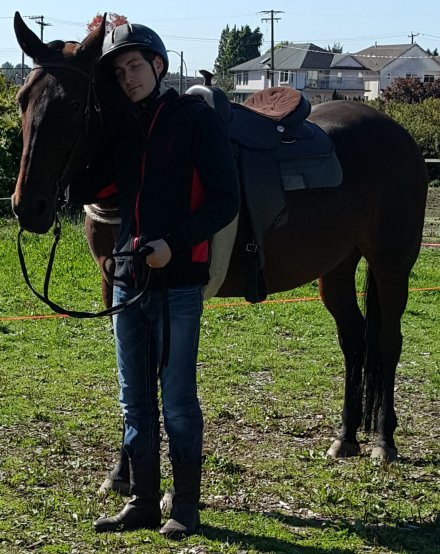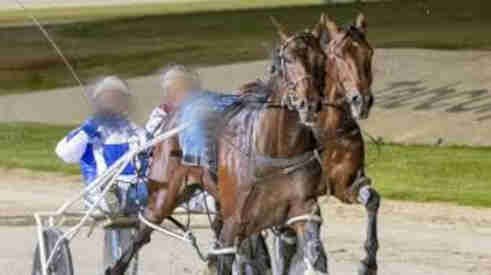

Most Standardbred horses are adopted from either the race tracks as pacers or trotters, the farm animal auctions or the rescues that take in former racing horses such as Thoroughbred, Quarter horses and pacers (Standardbreds).
Standardbred horses are well known for their solid and reliable temperaments which helps considerably in training. Horses that have been raced will need retraining no matter whether a Quarter horse, Thoroughbred horse or Standardbred horse.
Standie talents are many however like all former race horses there is rehabilitation and retraining required in preparation for a new career. A vet inspection to determine if there are any physical injuries that might prevent some of the more challenging equine sports is always recommended first when you adopt a pacer.
The biggest difference between these three breeds that are bred for racing is that both the Quarter horse and the Thoroughbred
have had a rider on their back: The horses know what a saddle is and how to be saddled. The trotters and pacers
(Standardbreds) have not been ridden or saddled as part of their racing career training - these horses are trained as harness
racers that pull a sulky with a sitting rider. All three breeds know how be bridled.

There are two basic methods associated with controlling a horse when riding: The western and english method. Western riding relies on neck reining with both reins in one hand to turn a horse whereas English riding uses both hands individually to hold each rein for turning and riding. Both riding styles pull back on the bit in the horse's mouth to slow down or halt the animal.
Western saddles tend to be bulky and on the heavier side. Some have attachments for gear such as camping or roping cows. The saddle has a knob protruding called a "horn" which is handy to hold on to (particularly when learning to ride and balance) and to use for cattle roping. Many equine sports rely on the western riding style such as endurance, search and rescue, trail riding, barrel racing, rodeo ridden sports and western pleasure competitions. The western saddle was built for comfort and longer riding journeys. The horse's bridle is simple and the most popular bits for the horse's mouth are called 'curb' bits: Steel bits with an upward groove mid-center that works on the roof of the horse's mouth and tongue. This article does not dwelve into teaching a horse western riding however the riding style is quite easy for both horse and rider to learn. Many Standardbred Fan Club members enjoy riding western as our Meet The Members shows!
I spent the $25.95 to download the Standardbred Fan Club's retraining video. I saved a bunch of money buying the horse and did the retraining myself like most people do from the video. The more difficult stuff like jumping needs an instructor but the pacers are so mellow you can trust that they wont be 'up in the air' which for horses being so big is reassuring.
Rodney
more retraining video reviews
The English riding style involves a much lighter, simpler saddle. The rider has to be balanced in riding since there is no support (like the 'horn' on a western saddle) to reach for in times of imbalance. Many riders enjoy this style because of more contact with the horse: It is easier to feel the horse's movements with the lighter, smaller saddle and the rein contact is more sensitive with the horse's mouth. It is imperative to have "independent hands" in riding english to prevent hurting the horse's mouth. Horses have many nerves in their mouths and the steel bit is not comfortable. English bits consist primarily of variations of the jointed bits such as the snaffle bit for greater control. English riding is common in fox hunts, English equitation, ring work, jumping and dressage (with some adjustments). Below are some scenes from the Standardbred Fan Club's Standardbred Horse Training - Retraining The Pacer video demonstrating the English riding style.
Kootenay learning trasistions from trot to canter / canter to trot without any pacing in the lunging ring.
Lacey had a harness racing career and would only pace after her racing career retirement. Here Lacey is learning to canter without any pacing gait.
Oliver was rescued from certain slaughter after his pacing races at the track. Here Oliver is warming up prior a dressage competition.
Some riders like to ride in both western and English. Horses can be trained in either or both. Depending on what you
enjoy with your Standie, either riding style has its pros and cons.
People who have Standardbred horses will tell you that they are one of the safest horses to ride in either style. They are mostly relaxed and calm. They are easy to saddle and groom. The Standardbred breed is known as the versatile horse - there are so many disciplines the horses are talented for - including trail riding, search and rescue, racing, jumping, endurance, 3 day eventing, barrel racing, movies, trick horses, police work, western riding, english equitation, dressage, parades, therapy horses and wonderful companions. Standardbred horses are willing, put their hearts to work for you and are safe to be with.